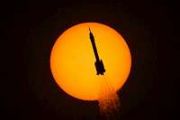
Copernical Team
Earth from Space: Danube Delta

The Copernicus Sentinel-2 mission takes us over the Danube Delta – the second largest river delta in Europe.
Selection begins | ESA’s next astronauts
 Video:
00:03:30
Video:
00:03:30
Work is under way to sort and assess applications from more than 22 500 ESA astronaut hopefuls. The rigorous selection process will take around 18 months. Initial screening to ensure that basic criteria are met will be followed by medical and psychological tests, exercises and interviews.
ESA plans to recruit 4-6 new astronauts through this 2021-22 selection round to support the future of European space exploration. This is likely to include missions to the International Space Station as well as the Moon. As part of the selection process, ESA is also assessing the feasibility of flying an astronaut
Volcanic trenches on Mars
 Image:
Image:
This image of the young volcanic region of Elysium Planitia on Mars [10.3°N, 159.5°E] was taken on 14 April 2021 by the CaSSIS camera on the ESA-Roscosmos ExoMars Trace Gas Orbiter (TGO).
The two blue parallel trenches in this image, called Cerberus Fossae, were thought to have formed by tectonic processes. They run for almost one thousand km over the volcanic region. In this image, CaSSIS is looking straight down into one of these 2 km-wide fissures.
The floor here is a few hundred metres deep and is filled with coarse-grained sand, likely basaltic in composition, which appears blue in the
Cassini’s wake: how might a spacecraft disturb its own measurements?

Simply by moving through the heavens, spacecraft change the space about them. Such interactions are invisible to the naked eye, but can endanger mission performance and safety. A new ESA Resarch Fellow study simulated the Cassini spacecraft in the vicinity of Saturn, checking their findings against actual space measurements. It reveals Cassini cast an ‘ion wake’ up to 6 m behind it, a void of plasma particles like a trail of a boat.
New spacesuit technology for moon and Mars exploration tested where Apollo astronauts once trained and tested spacesuits

Satellite in sun's backyard unravels the origins of interplanetary dust

What do shooting stars and astronaut safety have in common?
Both stem from the sub-microscopic rock fragments found throughout the solar system, sometimes called interplanetary dust.
When these particles collide with Earth's atmosphere, they create meteors, better known as shooting stars, as the (usually) microscopic fragments vaporize and leave flaming trails through the air. When they collide with astronauts, they can puncture holes in space suits—or worse. Understanding the sources and patterns of this interplanetary dust is therefore very important to NASA, as it plans for missions to the moon, Mars and beyond.
During its revolutions around the sun, the Parker Solar Probe spacecraft, the mission going closer to the sun than anything in spacefaring history, is bombarded by these dust particles. When crashing onto the spacecraft, the tiny grains—some as small as a ten-thousandth of a millimeter across—vaporize and release a cloud of electrically charged particles that can be detected by FIELDS, a suite of instruments designed to detect electric and magnetic fields.
A pair of papers publishing this week in The Planetary Science Journal use FIELDS data to take an up-close look at the "zodiacal cloud," the collective term for these tiny particles.
Webb completes testing
 Video:
00:00:45
Video:
00:00:45
Fully assembled and fully tested, the NASA/ESA/CSA James Webb Space Telescope has completed its primary testing regimen and is soon preparing for shipment to its launch site at Europe’s Spaceport in French Guiana.
Credit: NASA's Goddard Space Flight Center
Dates set for Space Station change of command as Franco-German relations awarded Media prize

The dates have been set for ESA astronaut Thomas Pesquet’s upcoming command of the International Space Station, as ESA astronaut Matthias Maurer prepares to join him on board.
Video: We asked a NASA scientist—do aliens exist?
Use this form if you have come across a typo, inaccuracy or would like to send an edit request for the content on this page. For general inquiries, please use our contact form. For general feedback, use the public comments section below (please adhere to guidelines).
Please select the most appropriate category to facilitate processing of your request
Replay: Cosmic Kiss news conference
 Video:
01:23:15
Video:
01:23:15
Watch the full replay of ESA astronaut Matthias Maurer’s pre-launch news conference at ESA’s European Astronaut Centre (EAC) in Cologne, Germany.
Held in both English and German on 9 September 2021, the conference covers ESA’s vision for human and robotic exploration as well as the science and operations Matthias will support on the International Space Station during his six-month Cosmic Kiss mission.
Cosmic Kiss is Matthias’s first space mission. He will be launched from the Kennedy Space Center in Florida, USA as a member of US Commercial Crew-3 alongside @NASA astronauts Thomas Marshburn, Raja Chari and Kayla Barron.
While in































